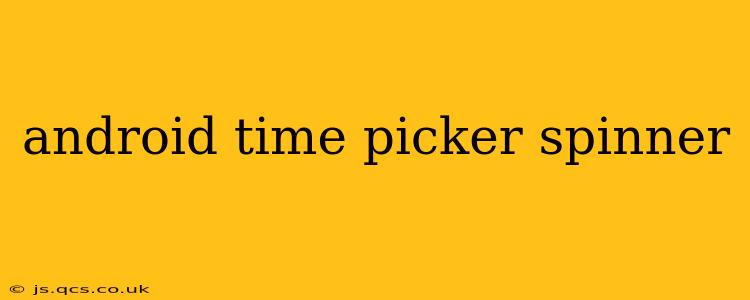Choosing the right time picker for your Android app can significantly impact the user experience. While the standard TimePicker dialog offers a basic solution, a more integrated and customizable approach may be needed for specific designs or functionalities. This guide explores the creation of a custom time picker using spinners for hours and minutes, offering flexibility and enhanced control over the visual presentation. We'll cover various aspects, from implementation details to handling user input and addressing potential challenges.
What is an Android Time Picker Spinner?
An Android Time Picker Spinner is a custom time selection component built using two spinners: one for selecting the hour and another for the minutes. Unlike the built-in TimePicker dialog, this approach provides greater control over the UI's appearance and behavior. This allows for seamless integration into your app's existing design language and offers advanced customization options. For example, you might want to limit selectable hours or display time in a 12-hour or 24-hour format with ease.
How to Implement a Time Picker Spinner in Android?
Creating a time picker spinner involves several steps. First, you'll need to design the XML layout to include two spinners. Then, you will populate these spinners with hour and minute values, and finally implement logic to handle the selection and retrieve the chosen time.
Here's a simplified outline:
1. XML Layout:
<LinearLayout xmlns:android="http://schemas.android.com/apk/res/android"
android:layout_width="match_parent"
android:layout_height="wrap_content"
android:orientation="horizontal">
<Spinner
android:id="@+id/hourSpinner"
android:layout_width="0dp"
android:layout_height="wrap_content"
android:layout_weight="1" />
<Spinner
android:id="@+id/minuteSpinner"
android:layout_width="0dp"
android:layout_height="wrap_content"
android:layout_weight="1" />
</LinearLayout>
2. Java/Kotlin Code (Kotlin example):
val hourSpinner = findViewById<Spinner>(R.id.hourSpinner)
val minuteSpinner = findViewById<Spinner>(R.id.minuteSpinner)
val hours = (0..23).map { it.toString() }.toTypedArray() // Adjust for 12-hour format
val minutes = (0..59).map { String.format("%02d", it) }.toTypedArray()
val hourAdapter = ArrayAdapter(this, android.R.layout.simple_spinner_item, hours)
hourAdapter.setDropDownViewResource(android.R.layout.simple_spinner_dropdown_item)
hourSpinner.adapter = hourAdapter
val minuteAdapter = ArrayAdapter(this, android.R.layout.simple_spinner_item, minutes)
minuteAdapter.setDropDownViewResource(android.R.layout.simple_spinner_dropdown_item)
minuteSpinner.adapter = minuteAdapter
hourSpinner.onItemSelectedListener = object : AdapterView.OnItemSelectedListener {
override fun onItemSelected(parent: AdapterView<*>?, view: View?, position: Int, id: Long) {
// Get selected hour and update time display
}
// ...other methods
}
minuteSpinner.onItemSelectedListener = object : AdapterView.OnItemSelectedListener {
override fun onItemSelected(parent: AdapterView<*>?, view: View?, position: Int, id: Long) {
// Get selected minute and update time display
}
// ...other methods
}
3. Retrieving the Selected Time:
Once the user selects hours and minutes, you can retrieve the chosen time using hourSpinner.selectedItem and minuteSpinner.selectedItem. Remember to convert these strings to integers before using them.
How to Customize the Appearance of an Android Time Picker Spinner?
Customization is a key advantage. You can change the appearance by modifying the style of the spinners, the background color, text size and color, and even replace the default spinner drop-down with a custom layout for a more polished look. Consider using a custom ArrayAdapter to achieve more advanced styling options.
How to Handle User Input and Validation?
Proper validation is essential. You might need to restrict input to valid hour and minute ranges, ensuring the selected time is always within reasonable bounds. You can implement this through OnItemSelectedListeners and appropriate error handling.
What are the Advantages and Disadvantages of Using a Time Picker Spinner Compared to the Default TimePicker?
Advantages:
- Customization: Offers significant control over appearance and behavior.
- Integration: Seamless integration into custom layouts.
- Simplicity: Can be easier to understand for less tech-savvy users.
Disadvantages:
- Development Time: Requires more code than using the default
TimePicker. - Accessibility: Requires careful consideration for accessibility features.
- Limited Functionality: Lacks advanced features of the
TimePicker(like AM/PM toggles if not explicitly implemented).
Conclusion
An Android Time Picker Spinner presents a powerful alternative to the built-in TimePicker, offering considerable flexibility and customization. While it requires slightly more development effort, the increased control over design and functionality makes it a valuable choice for many applications. Remember to prioritize user experience and accessibility when implementing your custom time picker.
